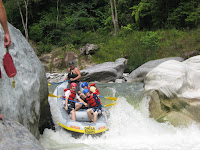At the jungle lodge here, we've twice rafted and once junge trekked. The rafting was billed as Class IV-V, which I was excited for never having rafted Class V's before, but it was a bit disappointing. In terms of what I like to know about a river, the class ratings of difficulty are a crude metric: somewhat ambiguous (dependent upon water levels and assigned by river guides, not an intl organization) and invalid (a nice rapid, if it has a log at the bottom under which someone could get caught and drown, could go from a Class III to a Class IV). Unfortunately water level was low, the guides had assigned generous classes, and much of the classification was for technical danger, not huge waves.
That having been said, it was Josh's first time, and it was still a rolling good adventure. My grandfather, a Second Lieutenant in WWII, pulled the same man out of the water twice during the war. And I had to do the same thing that day for the Honduran-born, British chap, Jamie, who was also in (and often out of) our boat. See the pictures at the bottom for the 2-meter drop we took. Our landing was less than a perfect 10.
For weeks, I have been congested. But in Copan and here in the jungles near La Ceiba, I've had fever and a vicious sore throat. Josh also suffers from a runaway nose; we sound our trumpets early and often. Fortunately, in our last day here, we appear to have turned a corner, which is crucial for our scuba-diving prospects in Roatan, our next destination. Finally, this will surely be the last entry for at least a week, as internet on Roatan is per Satellite only, so slow and expensive. Cheers.












